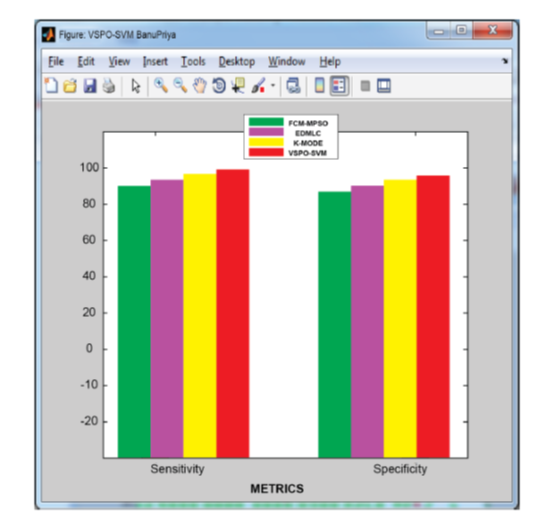


Indian Journal of Science and Technology
Year: 2021, Volume: 14, Issue: 16, Pages: 1250-1260
Original Article
Banupriya C V1*, Devi Aruna D2
1Research Scholar, Department of Computer Science, Dr.N.G.P Arts and Science College,
Coimbatore, 641048, Tamilnadu, India. Tel.: 9715789400
2Assistant Professor, Department of Computer Applications, Dr.N.G.P Arts and Science
College, Coimbatore, 641048, Tamilnadu, India
*Corresponding Author
Tel: 9715789400
Email: [email protected]
Received Date:11 April 2021, Accepted Date:18 April 2021, Published Date:06 May 2021
Objectives: To optimize the EEG signals in order to predict the epileptic seizures at early stage and to improve the accuracy level by employing genetic algorithm and machine learning methods. Methods: Virus Swarm Particle Optimization Technique (VSPO) based Genetic algorithm is utilized for the purpose of feature selection and Machine Learning SVM technique is utilized for classification of EEG signals to determine seizure or non-seizure. The Discrete Wavelet Transform (DWT) is utilized for factor extraction to assess the recurrence range of EEG signals associated with seizures, to partition them into separate spaces using DWT of EEG symbols, and to consider the variations between seizure and normal functionality. VPSO-GA with SVM extracts the features from the Andrzejak R G dataset and then selects the relevant function to perform classification and prediction in order to optimize the EEG signals for early ES prediction and to improve the accuracy level. To demonstrate the effectiveness of the proposed algorithm, MATLAB is used for implementation. The performance results are compared to the existing baseline versions FCM-MPSO, EDMLC and K-MODE. Findings: EEG signals are optimized and early ES prediction is done with 98.13% accuracy level, 98.03% sensitivity, 98.01% specificity, 98.90% Precision, 97.96% Recall, 191 True Positive, 104 True Negative and 98.46% F-Score to predict the seizure in an optimized manner which is high compared to the existing versions. Novelty: According to the findings of the comprehensive study, the proposed algorithm VPSO-SVM outperforms FCM-MPSO, EDMLC and K-MODE in terms of accuracy level of epileptic seizure prediction at early stage by optimizing the EEG signals in a robust manner.
Keywords: Epilepsy Seizure; Genetic Algorithm; Machine Learning Algorithm; Classification; SVM; DWT
© 2021 Banupriya C V & Devi Aruna D.This is an open-access article distributed under the terms of the Creative Commons Attribution License, which permits unrestricted use, distribution, and reproduction in any medium, provided the original author and source are credited. Published By Indian Society for Education and Environment (iSee)
Subscribe now for latest articles and news.